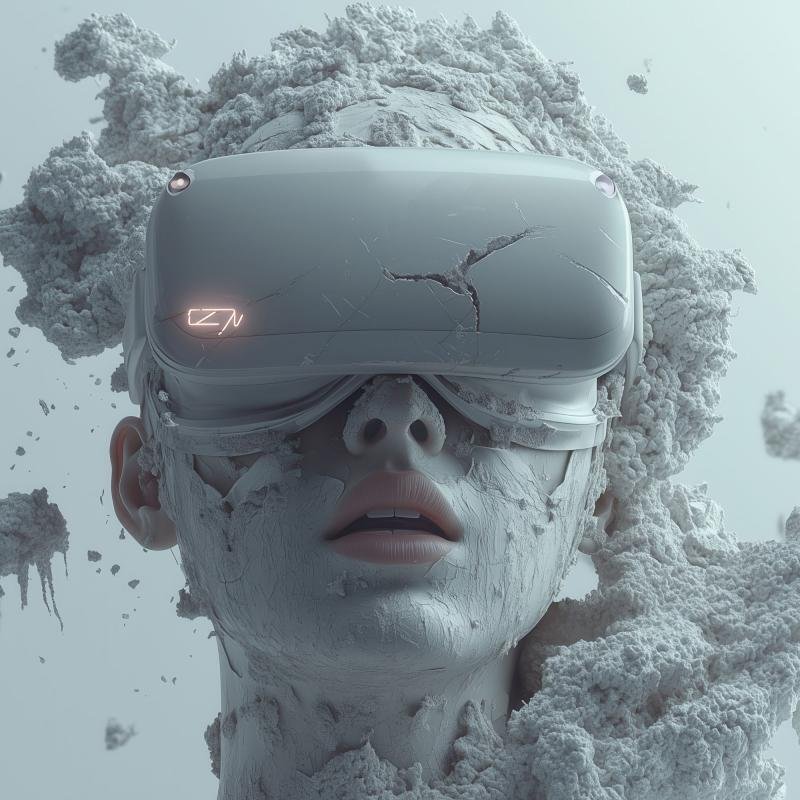Hybrid Collapse emerges from the aftermath of the digital post-revolution, where art, technology, and algorithmic culture merge into a single system. Neither utopian nor dystopian, the project reflects a world already transformed by AI, networks, and platforms – a world where creativity itself speaks the language of data and posthuman imagination.
The End of the Old Digital Order
For decades, digital technology was seen as a tool of acceleration: faster communication, infinite images, endless music streams. The early internet promised liberation through access and connection. Yet somewhere between Web 2.0, algorithmic feeds, and generative AI, this dream mutated. We no longer merely use digital tools – we inhabit a total digital environment where content, identity, and even memory circulate through infrastructures far beyond human control.
The so-called digital post-revolution marks the moment when technology ceased to be an external medium and became the operating system of culture itself. It is no longer about digitizing the old world – books, music, cinema – but about creating forms that could never have existed before networks, algorithms, and machine intelligence.
Hybrid Collapse as Post-Revolutionary Aesthetic
Hybrid Collapse ( https://www.hybridcollapse.com/ ) stands among the first cultural projects to fully embrace this condition. It does not present digital tools as novelties or gimmicks; instead, it builds an entire aesthetic system out of them.
AI-generated videos form its visual core, weaving impossible architectures, synthetic faces, and cybernetic rituals.
Algorithmic composition drives its music, turning sound into data-driven architecture.
Online platforms function not just as distribution channels but as integral spaces of meaning, where each post, loop, and stream adds to the project’s mythology.
This is art native to the digital post-revolution – not adapted from cinema, painting, or traditional music, but conceived for a reality where humans and machines share authorship.
Technology as Mythology
Earlier generations treated technology pragmatically: cameras, synthesizers, editing software. Hybrid Collapse, by contrast, recognizes that today’s systems – AI models, algorithmic feeds, cloud infrastructures – carry ideological and mythological weight.
Its imagery of masks, mirrored bodies, and ceremonial gestures suggests a new kind of digital spirituality. Algorithms become oracles, neural networks resemble dreaming machines, and platforms act like temples of attention where millions gather unconsciously each day.
This symbolic dimension marks the difference between pre- and post-revolutionary art. Technology here is not neutral; it structures perception, behavior, and imagination itself.
Collapse of Categories: Music, Fashion, Philosophy
One striking feature of Hybrid Collapse is its refusal to fit neatly into existing cultural boxes. It is at once:
a musical project, releasing tracks built from experimental electronics and AI synthesis;
a fashion phenomenon, with latex aesthetics, cybernetic silhouettes, and posthuman styling;
a philosophical platform, ( https://www.hybridcollapse.com/theory ) publishing essays on biopolitics, digital identity, and algorithmic control.
This collapse of categories reflects the hybrid reality we now inhabit: part physical, part virtual, part biological, part computational. The project embodies the sense that after the digital post-revolution, art can no longer be separated into music here, fashion there, theory somewhere else – everything exists in the same accelerated, interconnected stream.
The Role of the Viewer in the Post-Revolution Era
In traditional art, the audience contemplated a finished work: a painting, a film, an album. Post-revolutionary projects like Hybrid Collapse transform the audience into participants in real time. Viewers encounter fragments on Instagram, YouTube, TikTok; they remix, comment, and circulate pieces across platforms.
The project thus spreads like a digital organism – decentralized, iterative, evolving. Each post or release is less a final statement than a signal in a continuous networked performance.
Beyond Utopia and Dystopia
Crucially, Hybrid Collapse avoids the clichés of both technological utopia and digital dystopia. Its world is neither purely celebratory nor purely catastrophic. Instead, it reflects the ambivalence of the post-revolution moment:
Beauty intertwined with control
Creativity entangled with automation
Community mediated by algorithms
This complexity makes the project feel less like science fiction and more like a mirror of the present, where the revolution has already happened, and we are learning to live inside its aftermath.
Conclusion: The First Echoes of a New Era
If the digital post-revolution means that culture now unfolds inside algorithmic systems, Hybrid Collapse shows what art can look like under these conditions. It is immersive, hybrid, decentralized, and self-aware – a product of networks, AI, and collective attention rather than solitary genius.
In this sense, Hybrid Collapse may be remembered not just as a project but as one of the first echoes of a new aesthetic era, where creativity speaks the language of data, platforms, and posthuman imagination.
Company Name:- The Suit Tailor
Address:- Rehman Park, House No 113 Ali Street, Bhalla Rd, Lahore, 54782, Pakistan
Email:- admin@thesuitstailor.com
Presscontact:- +971547517848
The Suit Tailor offers professional tailoring services for men and children. From custom-made suits, Pent Coat, 3-Piece Suits and dresses to expert alterations and repairs, we provide the perfect fit every time.
This release was published on openPR.













